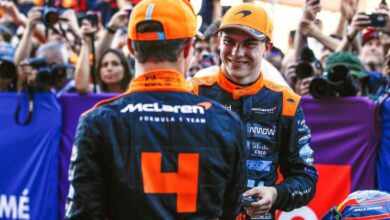Ferrari Faces Financial Strain as Carlos Sainz’s Crashes Impact Budget Amid Cost Cap Challenges
Carlos Sainz’s recent crash during Free Practice 2 in Abu Dhabi exacerbates financial woes for Ferrari, following a significant accident in Las Vegas. The team’s budget takes a hit as it deals with the repercussions of these incidents.
Key Takeaways:
- Carlos Sainz experienced two major crashes, first in Las Vegas during FP1 and then in Abu Dhabi during FP2. Both incidents have significantly strained Ferrari’s budget due to the high cost of repairs and replacements, particularly considering the damage to key components in the Las Vegas crash.
- Team Principal Fred Vasseur highlighted the financial impact of these crashes, noting the lack of budget provisions for such incidents under the cost cap. The Las Vegas crash alone resulted in damage to the car’s loom, gearbox, battery, engine, and impacted the team’s spare parts stock and overall budget.
- The end of the season is approaching, increasing pressure on teams like Ferrari to minimize expenses. Despite crashes being part of a team’s annual budget, the severity and timing of Sainz’s accidents have posed unique challenges.

Ferrari’s Formula 1 campaign has been marred by a series of unfortunate events, with Carlos Sainz’s recent crashes in Las Vegas and Abu Dhabi delivering a significant financial blow to the team. These incidents have come at a time when Formula 1 teams are under immense pressure to adhere to the stringent cost cap regulations, making every incident a potential budgetary nightmare.
In the world of high-speed racing, accidents are an inevitable part of the sport. However, the consequences of such incidents extend far beyond the track. Sainz’s crash during the Free Practice session in Abu Dhabi was not just a setback in terms of race preparation but also a major financial burden. This crash followed a severe incident in Las Vegas, where Sainz’s car suffered extensive damage after hitting a drain hole cover at over 300 kph. The Las Vegas crash was particularly costly, requiring the replacement of critical components like the car’s battery, gearbox, and engine. As a result, Sainz incurred a 10-place grid drop penalty for using a new battery.
Ferrari Team Principal Fred Vasseur, speaking in Las Vegas, expressed his concerns about the financial implications of these crashes. He stated, “There is no provision into the budget or cost cap, for excluding the crashes.” The damage from the Las Vegas incident was extensive, affecting not only the car’s performance but also the team’s financial planning and resource allocation. “We have a lot of consequences on the financial side, on the sporting side, and even on the stock of spare parts, and on the budget side for sure it’s not an easy one,” Vasseur added.
The second crash in Abu Dhabi further compounded Ferrari’s troubles. With the season nearing its end, teams are typically looking to conserve resources and minimize expenses. Ferrari, however, finds itself in a challenging position, having to deal with the aftermath of two significant crashes.
While teams generally factor in the likelihood of crashes into their annual budgets, the scale and timing of Sainz’s accidents are particularly problematic. The cost of repairing and replacing the damaged components, especially under the constraints of the cost cap, poses a significant challenge. The situation is exacerbated by the need to ensure the car is race-ready in a short timeframe, often requiring overnight work from the team’s mechanics.
In conclusion, Carlos Sainz’s recent crashes have not only impacted Ferrari’s performance on the track but have also created a complex financial scenario off it. As the team navigates the cost cap regulations and the end-of-season pressures, the focus will undoubtedly be on mitigating these challenges and ensuring a strong finish to the season.

